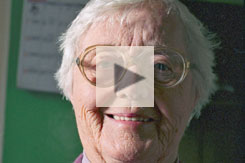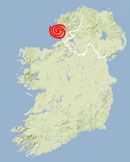29 Jul The Gleann Cholm Cille Turas
“Pattern day and the pilgrimage to holy well and ruined chapel…are things both Catholic and Irish, in which are interwoven, like the strands of a Celtic design, the symbols and ideas of the universal Church with others native to our soil. Indeed, the history of the development of the Irish pilgrimages is a microcosm of the history of religion in Ireland, for every age had added its own contribution to them.”
Daphne D. C. Pochin, The Irish Pilgrimages, 1954 1
“…the monuments have not remained aloof, unrelated to the people of the glen. They are part of a living tradition, and the well-trodden paths around many a cairn or standing stone are silent testimony that here the present has always met the past. In this, Gleann Cholm Cille is perhaps unique.”
Fr. James McDyer, 1971 2
Drag within the image to explore the stations of the Glencolumcille Turas in virtual reality.
An interactive map will appear when you click the button to view the VR in full-screen mode.
There are 28 different VR scenes. Touch here for the tablet version.
The Gleann Cholm Cille (Glencolumcille) Turas is a religious procession that incorporates 15 different stáisiúin (stations) within nine different townlands of this stunningly beautiful spot, at the western edge of Co. Donegal, where, as they say, “the next parish is Boston.” These stations are all ancient stone monuments, some of which may have been associated with pre-Christian practices. The Turas leads the pilgrim along a five and a half kilometer (3.5 mile) meandering path up into the hills and down thorough the valley. It has evolved through several distinct stages. More than a millennium ago it began at a time when this remote slice of Ireland, hemmed in by mountains and the sea, had its own way of perceiving the world. Much later, these processions went through a period of decline, when even the Church turned its back these devotional practices after some of them began to include more revelry than religion. And finally the Turas was revived by that same Church, in an age when the Celtic past was embraced as an emblem of the nation’s re-birth.3 Turas Cholm Cille is dedicated to St. Colm Cille, the 6th-century missionary who, according to local tradition, had a monastic center in the valley of Gleann Cholm Cille. It is today the longest turas still practiced in Ireland.
An Turas, means “the Journey.” These practices have also been called “patterns” or “rounds.” For the pilgrim it is a journey not only in the physical sense, walking barefoot in the darkness just after midnight as the ninth of June begins, plodding for three or four hours through rocky hillside and cold wet bog; it is also a path of spiritual discovery, where continually repeating the ancient mantra-like devotions brings one closer to salvation. That dark hour on the ninth of June in 597 was also the moment when St. Colm Cille was said to have taken his last breath.4
The 15 stations of An Turas, as well as the religious traditions associated with each of them, are all described in detail on a separate gazetteer page of Voices from the Dawn, along with photographs of each of the sites. Video interviews and other media items are also included on that page. Brief descriptions are contained in the “info” hotspots in the complete “Virtual Turas” (above). This VR feature should be viewed in full-screen mode to enable its interactive map. The Virtual Turas includes all 15 staden (stations) of the Turas, and also some additional features such as the Napoleonic-era watchtower high above the valley, and the souterrain (underground passageway) in the churchyard.
In traversing the route the pilgrim, starting at the Protestant Church in the valley, will climb 100 meters (328 feet) up a steep slope to reach St. Colm Cille’s Well, before descending and crossing Abar Dubh, the Black Swamp, to reach the stations at the second half of An Turas. Today pilgrims and visitors from all over the world follow the sequence of the Turas stations as described here and in the virtual-reality environment. However according to Liam O’Cuinneagain, the director of the Oideas Gael Irish language cultural center in town, parishioners traditionally used names and locations to identify the stations rather than numbers. They would begin An Turas at whichever station was closest to their homes, walking barefoot in the dark, until they had visited all 15 stations.5 An Turas is today performed primarily on Colm Cille’s feast day of June 9, but in the past it may have also been performed on Sundays, on three successive Fridays, and on other feast days.6
Colm Cille (c. 520 – c. 593 CE)7 is the saint who is honored in the Gleann Cholm Cille Turas. Most of the stations of the pilgrimage are connected in legend to this warrior-saint, the apostle to the Picts, who, it is said, battled demons and opposing tribes alike. There is very little contemporary written history on the life of Colm Cille, and nothing in the earliest written records to prove that the saint ever visited the valley that shares his name. But the associations—artifacts, folklore, and religious observations—that bind this place together with the story of Colm Cille may be stronger than those that link the saint anywhere else. Therefore it would appear foolhardy to ignore both the strong folk tradition in the Glen and the material evidence preserved in the Turas, which continues each year in this valley clinging to the western edge of Ireland.8
Colm Cille (“Dove of the Church”), or Columba in Latin, was never actually canonized by Rome. Yet he has been venerated as a popular “saint” since the end of the 7th century. He was born at Gartan, about 40 miles northeast of here, in central Donegal. The traditional spot of his birth, an ancient stone with prehistoric cupmarks, is perhaps a ruined Bronze Age tomb.9 The first station of the Turas in Gleann Cholm Cille is also a site repurposed from a similarly ruined 5,000-year-old monument.10
St. Colm Cille lived during the era that Ireland was making the slow transition from prehistory, the time of demons and Druids, to the early-Christian historic period. His first biography, the Vita Columbae, was written around 700 by his eighth successor, St. Adomnán, at the monastery Colm Cille established on the small island of Iona off the west coast of Scotland.11 The village of Gleann Cholm Cille does not appear anywhere in the text.
The next significant work on the life of Colm Cille wasn’t written until nearly five centuries later, between 1150 and 1182. The anonymous author of the Irish Life of Colm Cille wished to depict “12th-century aspirations in terms of the 6th-century lifetime of Colm Cille.”12 But Gleann Cholm Cille was not mentioned here either.
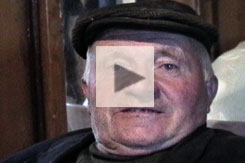
Turas leader Jimmy Carr describes the practices of the Turas (1999). Included are scenes from the 2001 midnight event.
The many old stories that today have become the folk traditions of the saint were compiled in 1532 by the Donegal aristocrat Mánus Ó Dónaill. He hired a team of writers who collected the bits and pieces of Colm Cille legends that were “scattered throughout the ancient books of Ireland.”13 In the preface of his Betha Colaim Chille (“Life of Columcille”) he declared that his goal was to make the reading easy, “so that it might be clear and simple to understand by all.”14 This book, the culmination of what had become a veritable industry of Colm Cille fable-making,15 was one result of each monastic center engaging every opportunity “to attract pilgrims with propaganda about the power of its patron saint.”16 It is here that we discover the first tales that connect Gleann Cholm Cille, the site of Turas Cholm Cille, with the legendary saint of Donegal and Iona.
The best known of these stories tells how St. Colm Cille battled a group of demons, eliminating them and their “black cloud and a fog dense and impervious to human sight” from Gleann Cholm Cille. It was recounted by Mánus Ó Dónaill, but likely was transcribed by his writers from earlier oral traditions.17 In this tale, a group of demons sought refuge in Gleann Cholm Cille (Senglenn, the “Old Glen”) after they were chased there by St. Patrick:
“And [the demons] raised a fog about them there, so that none might see the part of the land that lay beneath that fog. And of the river that formeth a boundary to the north they made a fiery stream so that none of all might go across it. And whoso should touch of that stream little or much, he should die straightway.
And angels of God revealed this thing to Columcille. And he went with many others of the saints to drive away the demons and banish them out of that place. And they made a stay beside the fiery stream we have aforementioned.
And they had not been long there when the Devil hurled a holly rod out of the fog across the stream. And it killed An Cere, Columcille’s varlet, with that cast…Thereat Columcille waxed exceeding wroth and he seized that same javelin, and hurled it across the stream. And the land was yielded to him for the space the javelin went into the fog, for the fog fled before that cast of Columcille’s.” 18
Some archaeologists suggest that there was an early Christian monastery in the Gleann Cholm Cille valley, one not connected with Colm Cille but rather one devoted to a local figure such as St. Fánaid, or St. Conal.19 It may have been centered in the same spot where the current 1828 Church of Ireland building now stands, as there is some evidence there of an ancient circular enclosure around the churchyard. The souterrain discovered in the church’s graveyard in the 19th century is normally a feature of an early monastic site.20 Photographs of the entrance and the interior of this souterrain are in the separate gazetteer page. This church sits astride the ruins of a prehistoric Court Tomb, perhaps destroyed with the original monastery’s construction. This tomb is the location of the first station of the Turas. At nearby Malin Mor, the restored Cloghanmore Court Tomb may be visited.
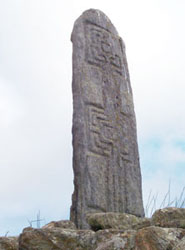
While St. Colm Cille may or may not have ever been in Gleann Cholm Cille, centuries after his death his successors probably sent missionaries here, after they were forced by Viking raids to leave Iona in the middle of the 9th century and settle back in Ireland. It is likely that the Colomban emissaries arrived here at this remote glen by sea, as it would have been an easy landfall for them.21 How different might the history of this place have been if these missionary mariners had chosen to take their most cherished object from Iona and bring that lavishly illuminated book to Gleann Cholm Cille rather than to Kells?
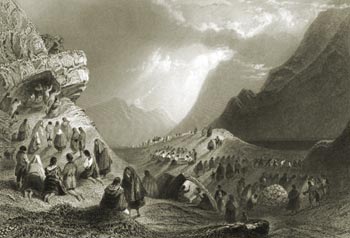
“A Pattern in Connemara,” engraving by W.H. Bartlett from his Scenery and Antiquities of Ireland, 1842.
The arrival of these new missionaries may have marked the beginning stages of An Turas, although it is not found in written records until its inclusion in a listing of penitential tours of 1543.22 The stories linking St. Colm Cille to the valley may have evolved as part of the effort to supplant existing tradition. One author suggests that the legend of St. Colm Cille and the Demons may be a symbolic representation of the battle against local pagan beliefs and practices.23 Likewise it can be said that the Turas itself represented “a moment when the communicant, having entered a holy site, leaves behind the profane world of everyday time and, through rituals, enters into a communion even union, with the divine.”24
It is tempting to imagine that some of the stones of the Turas, which most authorities say were erected in the eighth or ninth centuries,25 were originally used as pagan objects of devotion. Some of the early stories of St. Colm Cille, written at the start of the 8th century, depict his efforts at eliminating pagan practices. In one story the saint went to a well which the people believed was subject to a Druidic enchantment that made it poisonous. According to Adomnán, Colm Cille invoked Christ’s blessing on the water, and then he drank from it without harm, much to the chagrin of the local Druids. From that point forward, the story goes, the formerly toxic water had the power to cure disease.26 As Daphne D. C. Pochin Mould noted in 1954:
“The Celtic Church had to do two things, to end paganism and the worship of the well itself as a divinity; then to help the people’s transition to Christianity by bringing their old belief into a new orientation, water that heals through the prayers and blessing of a saint.” 27
St. Colm Cille’s Well, the sixth station of An Turas, may have been a place of pagan devotion, as were other naturally occurring springs in the country.28 The only Turas station that is unquestionably of prehistoric origin is the first one, the ruined Court Tomb. A second ruined Court Tomb, at Farranmacbride, lies on the route of An Turas between stations seven and eight; it may be visited in the VR tour. Most of the stations are topped by a remarkable collection of early Christian decorated cross slabs. These may have originally been grave markers, or they may have been erected specifically for the Turas.29
The transformation of the Celtic Church after the Norman Conquest and then the Reformation left a leadership vacuum in this remote part of the country, allowing indigenous beliefs and customs to accrue over the centuries regarding the different stations of An Turas.30 Thus, for example, the stone cover of a cist at Turas Station Five, perhaps the burial spot of an early monk, is now believed to be “St. Colm Cille’s Bed.” Pilgrims lie down on the stone, roll over on the “bed,” and remove some earth from underneath to invoke the blessings of the saint.
In some places, although perhaps not here, the once-holy processions were said to have degenerated so completely into lawlessness by the end of the 15th century that there were concerted efforts by the authorities, usually unsuccessful, to eliminate them entirely. This effort eventually extended to Gleann Cholm Cille.31 Farther to the east in Co. Donegal, at St. Patrick’s Purgatory, the pilgrimage was “abolished” by Pope Alexander VI in 1497. Then, in 1632, British authorities actually destroyed all the crosses and buildings there. They were soon rebuilt.32 In 1703 Queen Anne issued a proclamation,
“And whereas the superstitions of Popery are greatly increased and upheld, by the pretended sanctity of places, especially of a Place called St. Patrick’s Purgatory in the County of Donegal and of Wells to which Pilgrimages are made, by vast numbers at certain seasons…Be it further enacted that all such meetings and assemblies shall be deemed and adjudged Riots and unlawful Assemblies.” 33
The law specified that a fine of ten shillings was to be imposed unless the offending pilgrim agreed to be publicly whipped for his transgression. The tirades of the Protestant Ascendency against the reputed excesses of some of the turas practices continued, apparently with little effect. By the middle of the 19th century there was a renewed effort, even enlisting the Irish Catholic establishment, to eliminate, or at least to tame, the turas. In 1840 Philip Dixon Hardy, in his sometimes lurid screed against the extremes of these rural Catholic practices, quotes “a respectable Roman Catholic Prelate” writing of a turas in his diocese:
“It is become such a scene of drunkenness and quarrelling, and of other most abominable vices, that religion herself is brought into disrepute…intemperance and immorality are encouraged; the tranquility of the country is disturbed, and the seeds of perpetual animosities and dissensions are sown.” 34
The suppression of the Irish “pattern” (turas) was actually nearly completed by the middle of the 18th century. But afterwards, the Celtic revivals of the next century provided the new milieu for re-thinking the cultural value of such indigenous practices. The opinions of “romantic nationalism” celebrated the religious aspects of the turas as “evincing the continuing connection of an ancient Celtic soul and landscape…”35
Today, in Gleann Cholm Cille and a few other places, the turas is not only encouraged, but also often led by the parish priest, who has both revitalized and, in effect, taken ownership of the practice. The work of Father James McDyer (1910-1987) in Gleann Cholm Cille is a case in point:
“…watching the magisterial Father McDyer lead his people from station to station, one is tempted to conclude that the once wild pilgrimage so often condemned by the clergy is now but an extension of the church. The earth, it seems, has been disenchanted, and sacred geography has once and for all shifted away from the western edge and into the town…But the notion of a different sort of power, and perhaps a different sort of social world, is kept alive at the wells and in the discourse of the wells—the stories people tell about them.” 36
Click here to see all the notes from this page.
Continue to the Gazetteer page.
Gleann Cholm Cille Turas, Co. Donegal
Nearest Village: Gleann Cholm Cille
Latitude: 54° 42′ 37.9″ N
Longitude: 8° 43′ 24.1″ W
External Links:

